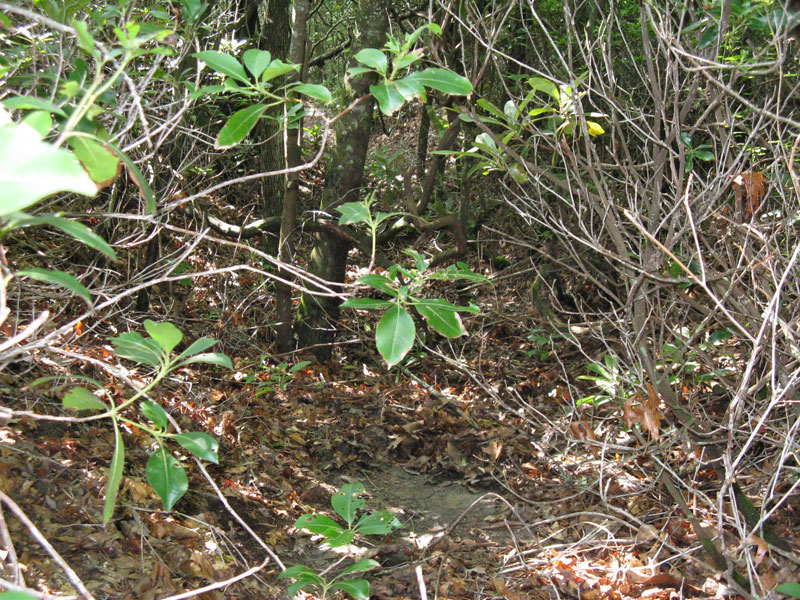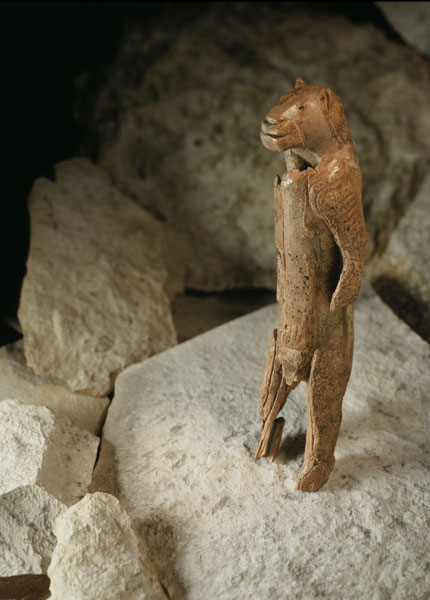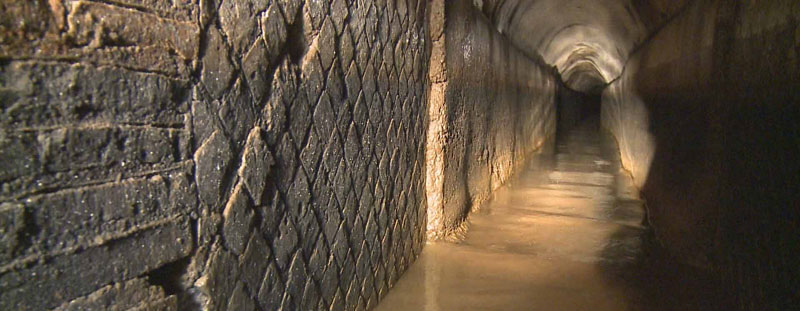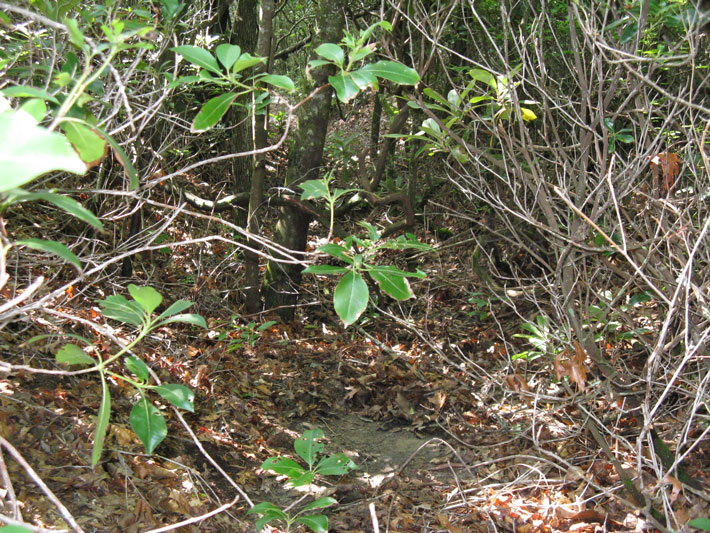
Long time we travel on way to new land. People feel bad when they leave Old Nation. Women cry and made sad wails. Children cry and many men cry, and all look sad like when friends die, but they say nothing and just put heads down and keep on go towards West. Many days pass and people die very much.
—A Cherokee account from The Oklahoman, 1929, cited by John Ehle in Trail of Tears: The Rise and Fall of the Cherokee Nation, 1988
It’s easy to miss this subtle groove, covered in pine straw and vines, worn in the ground of eastern Tennessee. In the summer of 1838, about 13,000 Cherokee walked this path from their homes in the Appalachian Mountains to a new, government-mandated homeland in Oklahoma. They traveled over land and water and were held in military camps along the way. Unlike other settlers heading west, who saw in America’s open expanses the hope of a new life, the Cherokee traveled with a military escort. They left behind highly coveted land that was, even as they walked, being divided up among white land speculators.
The Trail of Tears was a journey of some 900 miles that took approximately nine months to complete. After they were rounded up from their villages and homes, the Cherokee were assembled in large internment camps, where some waited for weeks before heading out in waves of approximately 1,000, following different paths, depending on the season.
As many as 4,000 died along the way from dehydration, tuberculosis, whooping cough, and other hardships— by some accounts, a dozen or more were buried at each stop. Some escaped along the way and were caught and returned to the march like criminals. Still others refused to leave, hiding out in the mountains, joining others on small farms where, stripped of tribal connections and burdened with unclear legal status, they faced an uncertain future.
Despite all our historical knowledge of the forced removal, there has been little study of the archaeology of the trail, the internment camps along the way, and the farms that sheltered those who stayed behind. The military forts that held the Cherokee in crowded, unsanitary conditions have been largely consumed by development or otherwise lost. The homesteads back East, where resistors lived under constant threat of arrest, went undocumented. Buildings, roads, farms, and floods have claimed almost all of these sites. In addition to a lack of material evidence, there has long been an uneasy, even contentious, relationship between Native Americans and archaeologists. Through neglect and distrust, this sad chapter has been at risk of fading from collective memory, taking with it any chance to understand the relationships between refugees and soldiers, and cultural information about the Cherokee themselves—what they carried, how they traveled, why they died.
That now stands to change. In eastern Tennessee, archaeologists are excavating the site of Fort Armistead, a U.S. Army encampment that served as a holding area and one of the first stops for North Carolina Cherokee on their forced journey west. Hidden deep in Cherokee National Forest, the site has managed to escape the damage or destruction that has visited nearly every other significant trace of the trail and camps. {page}
Fort Armistead lodged as many as 3,000 Cherokee over several months in 1838. Today, the site sits on about four acres of a mountaintop clearing. It consists of foundation blocks, collapsed piles of chimney stones, trash pits, and window glass—plus an enigmatic stone pipe—all settled gently into the ground, covered by only a thin layer of dirt, leaves, straw, and moss. For four weeks in the summer of 2011, archaeologists from the University of North Carolina at Chapel Hill (UNC), the U.S. Forest Service (USFS), and Lee University in Cleveland, Tennessee, held the fourth field season at the site. The same archaeologists also have been conducting excavations about 35 miles east, across the North Carolina border, at the sites of long-forgotten homesteads where fugitive Cherokee found refuge and community.
“Any [Cherokee] who came from North Carolina came through here,” says archaeologist Brett Riggs, an adjunct associate professor at UNC, of the Fort Armistead site. “We have an archaeological site and records that speak directly to it.”

Spindly hardwoods and pines surround the clearing. The archaeologists began their efforts in 2006 at the invitation of USFS officials, who had just purchased the property from private owners. Artifacts have been found throughout the immediate area, but the main digs of the 2011 field season focused on a space at the northern end about the size of two city buses. Exposed cut stones set in powdery soil, chimney blocks, and the remains of fire pits compose what was once the barracks area. Another foundation there probably supported the quartermaster’s residence, and a pit across the site likely served as a powder magazine. “You are right in the footsteps of the Cherokee,” says Quentin Bass, an archaeologist with the USFS. “[Fort Armistead] is the only example of a removal-era fort that essentially hasn’t been disturbed since the soldiers left. It’s the dream for an archaeologist—to find an untouched site to explore and preserve.”
These undisturbed remains of apparently substantial structures suggest that the federal government poured significant staff and resources into the fort during its military occupation. Beyond the barrack foundations, in a sunny opening in the tree cover, is a key public place, the fort’s parade ground. Wide dirt roads lead right and left beyond that, and a gentle slope leads down to a creek.
Fort Armistead was formally established in 1832, ostensibly to protect local Cherokee from gold prospectors. It was the only U.S. outpost in the Cherokee Nation, whose land at that time extended from western North Carolina and eastern Tennessee south through Georgia and into Alabama.
The fort was near a corridor that already served as a major source of cultural interaction, where different tribes traded, especially the Cherokee and the Creek (also known as the Muscogee). Cattle and pig rustlers, slave traders heading to South Carolina, gold miners, trappers, and hunters all came through along this route, known as the Unicoi Turnpike. Indeed, soldiers stationed at the fort often appropriated goods (including whiskey) for themselves, Riggs says. For the next several years, the fort was irregularly staffed and maintained.
Prior to the Civil War, trade and land speculation in the South often put businessmen and speculators at odds with Native Americans who occupied the land they coveted. The federal response to this problem was the Indian Removal Act, which passed by a narrow margin in 1830. The law marked a monumental shift for the young nation by officially claiming Native lands for its expanding population and farming needs. The act granted the Natives money and land in the West if they left their homes in the South. To sell the act to the public, the federal government asserted that Native Americans were primitive migrants—hunter-gatherers who would not be able to modernize. It was also cast as a measure to protect Natives from more violent efforts to claim the land on which they lived. However, it clearly overlooked that many tribes throughout the Southeast lived in villages and towns and were adept pastoralists, farmers, and entrepreneurs, with strong spiritual ties to their lands. President Andrew Jackson, a land speculator himself, championed the controversial act and stood to profit from it. In the ensuing decades, the legislation stoked moral outrage that also helped fuel the abolitionist movement.
The Cherokee fought eviction through official channels, eventually winning support for independent status from the U.S. Supreme Court—a decision that prompted Jackson to say, “[Chief Justice] John Marshall has made his decision; let him enforce it now if he can.” Harassment, uncertainty, and eroding negotiating leverage ultimately fatigued the Cherokee. In 1835, a minority Cherokee group agreed to relocation, or removal, under the terms of the Treaty of New Echota. Deportation might then have seemed a kind of escape. The treaty included $5 million for the tribe, along with compensation for the land and possessions they abandoned.
The Cherokee, which white Americans called one of the Five Civilized Tribes, considered themselves American and wanted to join the growing country as participating members. In 1827, the Cherokee ratified a constitution modeled after the American one. They also assumed some aspects of American culture, in an effort to acculturate and escape the fate they had seen befall other Southeastern tribes, such as the Choctaw, the first tribe to move to the West in 1830, or the Seminoles, who violently resisted removal from Florida.
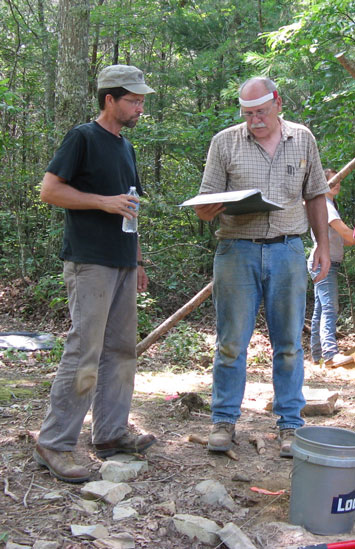
“The Cherokee were trying to play by American rules,” says archaeologist Lance Greene, who worked with Riggs at UNC and now works at the Fort Armistead dig. “They were forming their own national government. A large part of the population had converted to Christianity. They sang Christian hymns as they were marching. There’s still an image of savage Indians living in tepees, but maybe the Cherokee, more than anybody, made an attempt [to acculturate]. But ultimately it failed.”
Despite the apparent Cherokee desire to join instead of fight, the federal government began a military buildup in preparation for what it assumed would become a long, bloody conflict. As part of this militarization, they reactivated Fort Armistead in 1836 and occupied it with soldiers who marched there from Florida. By the summer of 1838, more than 7,000 federal and state troops were stationed throughout the Cherokee Nation—a remarkably high concentration for America’s nascent military.
“What drove their idea of a protracted conflict in North Carolina was the unanimous opposition to the Treaty of New Echota and strong activism to prevent its ratification, and then to have it annulled,” Riggs says. “There were rumors afoot that there would be a guerilla war in North Carolina. The military was poised for an eventuality that never happened.”
There was no insurgency and little resistance when the military began the roundup of the Cherokee in June and July 1838. Most of them gathered what belongings they could and came together in their town squares or waited for a soldier’s knock on the door (though some did seek refuge in the mountains). Coming together as they accepted their fate became a final act of preservation for their families, communities, and values, Riggs says. “They were trying to promote the cohesion of their group,” he adds. “They were making a political statement, a moral statement. They believed very strongly in the ideals of this country and the moral imperative to treat everybody fairly.”
For Cherokee living in North Carolina, Fort Armistead was the first stop outside their home state. It held as many as 800 to 1,000 for stays of two or three nights. These included not only the Cherokee, but also those traveling with them, including Creek and African Americans, some of them slaves. They continued on to a series of other outposts (there were up to 30 forts or stops along the trail) in Tennessee, including Fort Cass, the main holding site, near present-day Charleston, which was known for its especially unbearable conditions. In summer 1838, when drought made river levels so low that a planned river route became impossible—and heat made an overland course deadly—the march was delayed until fall, leaving thousands of Cherokee to languish there to face disease and death.
Once the Cherokee were moved and soldiers left in 1838, Fort Armistead was abandoned. From the Civil War period through the turn of the century, the site was privately owned, until it was purchased by the USFS in 2005, and archaeological exploration began the next year.
“We poked around and realized that, in fact, the site had never been plowed,” Riggs says, a common fate for many archaeological sites in the Southeast. “Many of the anomalies that we were seeing on the surface, which I thought were small piles pushed up by a bulldozer, were melted chimneys and cellar pits that had been filled in [by settling debris].” Riggs says the site is in “as nearly pristine condition as you find in the East.
“When you start, you are immediately within an archaeological feature. You have to approach it with kid gloves from the outset,” he adds.

The 2011 dig season, which also included Bass and students from Lee University, focused on several large architectural features, primarily the quartermaster’s house and the enlisted-men’s quarters. The foundation stones easily emerged from the surrounding dirt, lying so near the surface that in many cases soil could be removed by vacuum. The archaeologists discovered a surprising solidity and permanence to these structures, suggesting a highly organized and militarized approach to the removal of the Cherokee. In addition, the stone most likely was brought from up to five miles away, indicating extensive manpower was likely needed for the construction.
“The structure was even more substantial than we thought,” Greene says. “It’s almost a solid rock floor. If you have something that heavy, then you’re almost building it as a foundation for a cannon. But they didn’t have that firepower at the camp. They may have overbuilt some of the structures to keep the soldiers occupied. They must have had a stonemason who was skilled enough to do that work. The stone is cut to make very tight joints. They’ve done some fine stone work.”

The seemingly grand military scale of the fort was not necessary to control the Cherokee, the demeanor of whom has been described as subdued and orderly. The fort grounds ordinarily used for drills may instead have served as a sleeping and cooking area for the internees. Direct evidence of Cherokee at the fort—or anywhere along the Trail of Tears for that matter—is vanishingly rare. Yet one find at Fort Armistead not only confirms the Cherokee presence in the area before their removal, but also suggests what sort of artifacts might be unearthed that could help reveal how the Cherokee and the soldiers stationed there interacted.
The broken remains of a carved stone Cherokee pipe were discovered at the site of the soldiers’ barracks. The pipe, which was probably discarded before it was fully carved, was found in a deposit with military regalia that date it to a time before removal. So while it says little about the experience of the Cherokee as they were interned there, it implies that before removal, “you had Cherokees coming in and hanging around the fort,” Riggs says.
“To find evidence of their presence is amazing,” Greene adds. “[The soldiers and Cherokee] are dealing with each other on a face-to-face basis. It brings up those questions, makes you think about what happened on the ground. How could you explain this?”
Other finds in 2011 include ceramics, such as pearl ware, and glass dating the site to the removal period. A faceted blue glass bead, from the 1820s or 1830s, emerged from the foundation stones (and may, in fact, be of Cherokee origin). Also, more than 4,200 distinct metal objects have been documented.
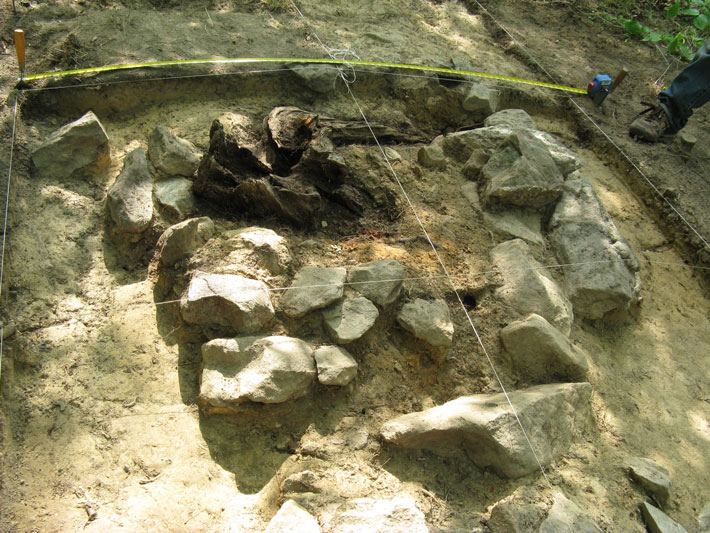
The excavation and study of the site of Fort Armistead is beginning to flesh out the story of those who left. Now, the Cherokee, whose capital is Tahlequah in eastern Oklahoma, number some 300,000—comprising the United States’ second largest tribal nation. But the small band of Cherokee who stayed behind left a smaller but still significant legacy in southern Appalachia. It is estimated that about 400 Cherokee remained in North Carolina after the others were removed. They hid in the mountains where, unable to trade publicly, they found ways to survive by cooperating with one another. They often lived together in homesteads, and the Eastern Band of the Cherokee, which today numbers about 10,000, descends from residents of those homesteads.
In Andrews, North Carolina, just over the border from his work at Fort Armistead, Greene is excavating a farm once owned by John Welch, a Cherokee, and his white wife, Elizabeth. After removal, the state took over their land. John avoided relocation to Oklahoma because of his marriage, and Elizabeth repurchased the farm, where they further defied the Indian Removal Act, Greene says. There, they sheltered about a hundred Cherokee refugees. At the homestead site, Greene has found bones of rabbit, deer, and small game animals, such as songbirds. Among the food traces, there is a notable lack of long bones, which Cherokee often cooked and cracked open for the marrow. Greene says this is a significant cultural marker—the family continued many Cherokee practices. “One of the strongest signs of that is the food remains,” he says.
The Welch settlement and others, perhaps hundreds yet undiscovered, will help explain the different experiences and separate paths of the two groups of Cherokee split by the trauma of removal. “In a broad sense, for all Cherokees, the removal is a watershed event,” Greene says. “It’s tied to the broader tribal history of tragedy and trauma.” It divided the tribe, but also, he suggests, forged the resilience and character of the modern Cherokee.

In 1987, Congress designated the Trail of Tears National Historic Trail, about 2,200 miles across nine states. Fort Armistead is on the trail and is a remarkably fragile site. Hidden cameras, motion monitors, and a high-tech security system protect it from looters and unauthorized visitors. Among the visitors allowed at the site are Cherokee from Oklahoma, whose ancestors surely passed through the fort.
For archaeology student Beau Carroll, a Cherokee who grew up in western North Carolina, excavating at the site of Fort Armistead allowed him to experience a deeper connection with his past. He remembers his late great-grandmother telling him of being sent to boarding school, as many Cherokee children were, where she was instructed to follow white American traditions. She cried when she remembered it, he says. Working at the site gave him “an indescribable feeling, a really sad feeling.
“When I’m working, the archaeologist in me gets really excited,” says Carroll. “I forget where I am. But then I take a break and look at that trail, and I can’t believe what happened.”


